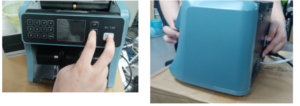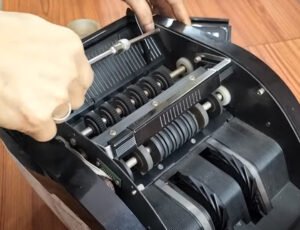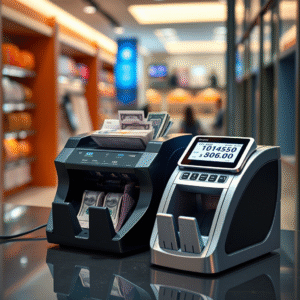Sa napakabilis na mundo ngayon, ang mga negosyong humahawak ng malalaking volume ng cash ay nangangailangan ng maaasahan at mahusay na mga makina upang mabilang ang kanilang pera. Ang mga mixed denomination money counter machine ay isang game-changer sa bagay na ito, na nag-aalok ng mga natatanging bentahe sa pamamagitan ng pagproseso ng iba't ibang mga denominasyon ng bill nang sabay-sabay. Sa komprehensibong gabay na ito, tutuklasin namin ang mga feature, benepisyo, tip sa pag-troubleshoot, at kung paano pumili ng tamang mixed denomination money counter machine para sa iyong mga pangangailangan sa negosyo.
Ano ang Mixed Denomination Money Counter Machine?
Ang mixed denomination money counter machine ay isang advanced na device na maaaring magbilang ng iba't ibang denominasyon ng currency nang sabay-sabay. Hindi tulad ng mga tradisyunal na makina sa pagbibilang ng pera na nagpoproseso lamang ng isang denominasyon sa isang pagkakataon, ang mga mixed denomination machine ay idinisenyo upang makita at paghiwalayin ang mga bill ng iba't ibang mga denominasyon habang sila ay ipinapasok sa makina.
Ang ganitong uri ng makina ay partikular na kapaki-pakinabang para sa mga negosyong nakikitungo sa iba't ibang uri ng pera, gaya ng mga bangko, casino, retailer, at foreign exchange office.
Mga Pangunahing Tampok ng Mixed Denomination Money Counter Machine
Nasa ibaba ang mga nangungunang feature na maaari mong asahan sa isang de-kalidad na mixed denomination money counter machine:
| Tampok | Paglalarawan |
|---|---|
| Multi-Denomination Detection | May kakayahang magbilang at mag-uri-uri ng maraming denominasyon nang sabay-sabay. |
| Pag-batch at Pag-uuri | Awtomatikong pinagbubukod-bukod ang mga bill sa iba't ibang denominasyon, na tinitiyak ang mabilis at tumpak na mga bilang. |
| UV at MG Detection | Nilagyan ng UV (ultraviolet) at MG (magnetic) detection para matukoy ang mga pekeng bill. |
| Mataas na Bilis ng Pagbilang | Ang mga advanced na makina ay maaaring magbilang ng libu-libong singil bawat minuto, na nagpapataas ng kahusayan sa mga abalang kapaligiran. |
| LCD Display | Mga malinaw na LCD display na nagpapakita ng bilang ng bawat denominasyon nang hiwalay, na nagpapahusay sa transparency at katumpakan. |
| Pagsasama sa Software | Maraming machine ang may software compatibility, na nagbibigay-daan para sa madaling pamamahala ng data at pag-export. |
| Error sa Paghawak | Awtomatikong nakakakita ng mga jam, maling pagbilang, o maling mga bill ng denominasyon at inaalerto ang user. |
Mga Benepisyo ng Paggamit ng Mixed Denomination Money Counter Machine
Ang kakayahang magproseso ng maraming denominasyon nang sabay-sabay ay simula pa lamang. Narito ang mga pangunahing bentahe ng paggamit ng mixed denomination money counter machine:
- Kahusayan ng Oras: Ang mga tradisyunal na paraan ng pagbibilang ng bill ay nangangailangan ng manu-manong pag-uuri at pagbibilang. Sa isang mixed denomination machine, nakakatipid ka ng malaking oras habang awtomatiko nitong pinagbubukod-bukod at binibilang ang mga singil.
- Tumaas na Katumpakan: Gumagamit ang mga makinang ito ng mga sopistikadong sensor upang tumpak na bilangin at makita ang bawat denominasyon. Binabawasan nito ang pagkakamali ng tao at pinapabuti nito ang katumpakan ng iyong pamamahala sa pera.
- Pinahusay na Seguridad: Sa pamamagitan ng mga mekanismo ng pagtuklas ng pekeng tulad ng mga sensor ng UV at MG, nakakatulong ang magkahalong denominasyon na mga counter ng pera sa pagtukoy ng mga pekeng singil, sa gayon ay mapangalagaan ang iyong negosyo.
- Pinahusay na Produktibo: Ang mga empleyado ay maaaring tumuon sa iba pang mga gawain sa halip na gumugol ng oras sa manu-manong pagbibilang ng pera, sa gayon ay mapabuti ang pangkalahatang produktibidad.
- Kakayahang umangkop: Nakikitungo ka man sa lokal na currency o foreign notes, ang isang mixed denomination machine ay umaangkop sa iba't ibang bill at currency, na ginagawa itong mahalagang tool para sa mga negosyong humahawak ng mga internasyonal na transaksyon.
Paano Gumagana ang Mixed Denomination Money Counter Machines
Gumagana ang mga makinang ito gamit ang advanced na teknolohiya ng sensor na nakikita ang denominasyon ng bawat bill habang dumadaan ito. Gumagamit sila ng kumbinasyon ng mga optical at magnetic sensor upang pag-aralan ang mga bill para sa laki, kulay, at magnetic na mga katangian. Pagkatapos, ikinategorya ng makina ang bawat bill batay sa denominasyon nito, binibilang ang mga ito, at ipinapakita ang resulta sa screen.
Narito ang isang step-by-step na breakdown kung paano gumagana ang proseso:
- Pagpapakain ng mga Bill: Ilagay mo ang pinaghalong mga bill sa hopper.
- Proseso ng Pagtuklas: Nagsisimulang i-scan ng makina ang mga bill gamit ang mga sensor ng UV at MG upang matiyak ang pagiging tunay at matukoy ang denominasyon.
- Pag-uuri at Pagbibilang: Ang mga bayarin ay pinagbubukod-bukod sa magkakahiwalay na stack batay sa kanilang denominasyon at awtomatikong binibilang.
- Pagpapakita: Ipinapakita ng makina ang kabuuang halaga para sa bawat denominasyon sa screen, na nag-aalok ng malinaw na pangkalahatang-ideya ng mga resulta.
Pagpili ng Tamang Mixed Denomination Money Counter Machine para sa Iyong Negosyo
Kapag pumipili ng isang mixed denomination money counter machine, may ilang salik na dapat isaalang-alang. Narito ang isang simpleng gabay upang matulungan kang gumawa ng tamang desisyon:
| Salik | Pagsasaalang-alang |
|---|---|
| Uri ng Pera | Tiyaking sinusuportahan ng makina ang partikular na currency o mga currency na pinag-uusapan ng iyong negosyo. |
| Bilis ng Pagbibilang | Kung humahawak ka ng malalaking volume ng cash, mag-opt for a high-speed machine na kayang magproseso ng daan-daan hanggang libu-libong bill kada minuto. |
| Pagtuklas ng Peke | Tiyakin na ang makina ay may maaasahang mga kakayahan sa pagtuklas ng pekeng (UV, MG, IR sensor). |
| Kapasidad | Isaalang-alang ang kapasidad ng hopper, dahil mangangailangan ang malalaking negosyo ng mga makina na may mas mataas na kapasidad sa paghawak ng bill. |
| Sukat at Portability | Pumili ng makina na akma sa loob ng iyong workspace at maaaring ilipat kung kinakailangan. |
| Presyo | Nag-iiba-iba ang presyo batay sa mga feature, kaya pumili ng isa na akma sa iyong badyet habang nag-aalok ng mga kinakailangang feature. |
Maaari mong tuklasin ang iba't ibang mga mixed denomination money counter machine sa Dongbo 2008 Money Counting Machines.
Pag-troubleshoot ng Mga Karaniwang Isyu sa Mga Mixed Denomination Money Counter Machine
Sa kabila ng kanilang advanced na teknolohiya, ang mixed denomination money counter machine ay minsan ay nakakaranas ng mga isyu. Narito ang mga karaniwang problema at solusyon:
1. Mga Paper Jam
Solusyon: I-off ang makina, tanggalin nang mabuti ang mga bill, at siyasatin ang loob kung may anumang debris o jammed bill. Linisin ang mga roller at sensor upang maiwasan ang karagdagang mga jam.
2. Maling Pagbilang ng mga Bill
Solusyon: Suriin kung ang mga singil ay maayos na nakasalansan at nakahanay. Tiyaking na-calibrate nang tama ang software ng makina. I-recalibrate ang makina kung kinakailangan.
3. Pagkabigo sa Pagtuklas ng Peke
Solusyon: Linisin ang mga sensor ng UV at MG gamit ang isang malambot, tuyong tela upang matiyak na hindi sila nahaharangan ng dumi o alikabok.
4. Mga Mensahe ng Error
Solusyon: Sumangguni sa manwal ng gumagamit para sa pag-troubleshoot ng mga error code. Maaaring may kasamang misalignment, mga isyu sa sensor, o maling input ng bill ang mga karaniwang error.




